Alison M. Jones: Press
Images © Alison M. Jones. All rights reserved.
|
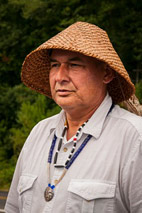
Ray Gardner
Excerpts from NWNL Interview with Ray Gardner,
Chair of the Chinook Nation
June 2007
Interview conducted and condensed by Alison M. Jones
NWNL: Thank you, Ray, for bringing us to this protected Columbia River cove, so imbued with the spirit of the Chinook Nation. As we sit here on this Pacific Northwest river, could you describe the historic ties Chinook Nation has had with the Columbia River.
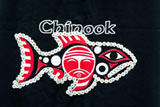
RAY GARDNER: The best way to start with that is from our story of creation. We were created on the Columbia River. The Creator and Mother Earth gave us the honor to be a people that lived on this river. This river was a means of transportation. It was a means of communicating with other tribes up and down the river in our canoes. It provided us with the salmon that Coyote taught us how to fish. Historically, our range was from south of Grays Harbor down through Willapa River and down south of the Columbia to what would be modern day Seaside. Then we went up [along the coast] to right about where Vancouver is today.
We were among the biggest traders of the Pacific Coast up Northern Canada to the border of Alaska. Our average ocean-going canoes were 70 feet long. We traveled from the Columbia River north to Canada and south to mid- and a little bit of southern California. That was our normal trade area. From the mouth of the river up to Celilo Falls [flooded by the Dalles Dam in 1957], we used canoes that on average were 50 feet long and carried a crew of 20, plus cargo. In fact, we had trade goods from China long before the Euro Americans got here.
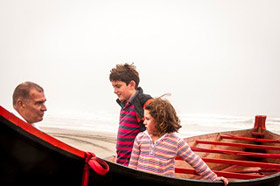
Ray Gardner with direct descendants of William Clark, co-leader of the 1804-6 Lewis and Clark Expedition that over-wintered in Chinook territory.
NWNL: How do you maintain traditional Chinook values for yourself and how do you instill them in your children?
RAY GARDNER: For me to find the energy and wisdom and strength from the ancestors, it’s places like this [Chinook Cove] where I can get that. You have to come where they lived, where they existed.
From a tribal side, it’s really an immersion into culture. It’s letting children know from “Day One” that this is who you are; this is where you came from; this is your Story of Creation; this is what the Creator taught us; this is how Coyote taught us to fish. It’s all of those things. It’s taking the time and being willing to sit down with the children. It’s talking to the children when they’re at a young age – before society as a whole grabs them and starts to get them into modern technology and everything else – because then it’s harder to get their attention and hold it.
NWNL: What practices have Native Americans traditionally followed to keep our rivers healthy?
RAY GARDNER: It’s really hard to put into words not only how important this river system was, but still is. We have always known that if the people here do not protect Mother Earth, she can’t exist. So, it’s very important to keep all elements of Mother Nature pure and safe.
It’s very important to the Chinook people to preserve this river, as we were only allowed to be here by the Creator. With that came the honor of being the people to protect this part of the river. And to protect that, we had to be careful to not pollute the river. The cleanliness of the river and the purity of the river are very important because, obviously, for salmon to survive, they have to have a good water system. Even when our canoes are taken in and out of the water, they are cleansed.
The Creator always told us only take what you need – do not waste. And what you take, you use all of it. In the same respect, you have to do that same thing with the river. Again, it really goes back to the story of creation. It goes back to when were we brought here, why were we brought here, what were we honored to be part of and what were we tasked to take care of. And if we go back to those things, then culture – in and of itself – tells us we have to do whatever we can to protect these rivers.
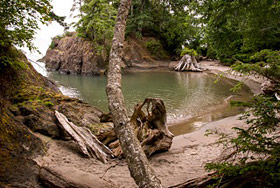
Chinook Cove of the Columbia River
NWNL: How do Native Americans honor healthy rivers and salmon populations today?
RAY GARDNER: It’s very deeply ingrained all of the native people. Our concerns are with educating the public and with getting better practices out there. That we can help with.
One of the things our people plan is river-area cleanups. Many of our people will come down to this cove, to this beach, to pick up whatever debris has been left behind. When you take that and magnify it by the length of the Columbia River, you start to get a grasp on the problem. For the tribal people, it warms our hearts to know that there are also other people out there trying to help us do what we know needs to be done.
NWNL: How does the Chinook Nation extend its stewardship values beyond its own tribes?
RAY GARDNER: I think about how our tribe has survived, how we have existed, and how we co-mingle with our surroundings and the people that we deal with today. The tribes of today are not the tribes of our forefathers. We’re a group of people that are educated in every aspect of what goes on. We’re educated in marine biology, we’re educated in forestry and we’re educated in law. We see the importance of getting our people educated in all those fields. Doing that will help the entire planet when it’s all done, because there are literally thousands of years of the spirits of our ancestors that are here.
Along the entire river system there has been a history of neglect, so we have to be able to figure out ways to partner with our communities, and to help communities as a whole thrive. I have pushed very hard with local cities, towns, counties and state government agencies to show them how letting the tribes work with them can help teach them how to preserve what’s here. I have also worked on how to bring an economy into an area that won’t affect the environment but will provide jobs for the people.
NWNL: What do think about dams and other infrastructure placed along our rivers?
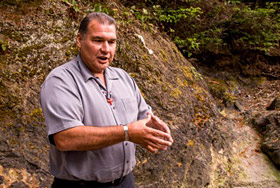
RAY GARDNER: Dams have affected the spawning rituals of the fish and diverted them; they’ve held fish up so predators can get them. Any numbers of things have happened, just from the fish side, with the dams. They do need to provide better passage for the fish. There is no question that entire fish runs are being lost and decimated. You just look at the numbers of fish that go through the dams and, except for a few peaks, they are continually dwindling and getting smaller.
The dams – and altering the flow of the water – have totally devastated certain areas of the river on both sides. They’re doing the river no good. They’re heating the water up, they’re doing different things that this river was not meant to have happen. As you get further up the river, there used to be natural flow irrigation systems and very lush fields with vegetation and crops that were very substantial for the plateau tribes. Once the dams were put in, all of that was put under water. You go up there now and those areas are just dead. The crop structures are gone; the vegetation is gone.
Anytime you alter or make any deviation in the river – even in the flow of the water – the impacts are huge. I don’t think people really take the time to stop and look at impacts. Even if you’ve made a slight deviation of water flow, you’re eroding a bank over time and with that bank erosion are you now putting silt into the water that goes into the spawning bed. The fish then can’t spawn anymore because the gravel surface is now buried in silt. So, any type of industry that is going to do anything in or around the water is a concern. I say that because the smallest of things can have the biggest of impact.
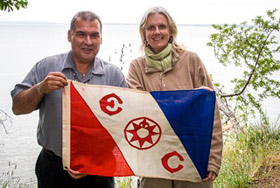
Ray Gardner and NWNL Director Alison Jones with an Explorers Club Expedition Flag. © Bonnie Muench, NWNL expedition member.
NWNL: Traveling along the Columbia from its British Columbia source down to its Pacific Ocean terminus, our NWNL expedition has recorded many voices from tribal nations in this watershed. It seems that the Pacific Northwest tribes are strong leaders in the push to protecting this great river.
RAY GARDNER: They really are. It’s been nice to see; and it goes beyond protection of just the river because the rivers actually have everything to do with Mother Earth. As the tribes are gaining in education, they’re getting into all aspects of cleaning up the river’s systems and keeping them healthy. They’re looking at forestland practices and how to get yields of timber out of the forest without destroying the land, aquifers or small forest streams. They’re looking at how they can better keep vegetation in places where it needs to be and make sure it’s not being taken out. They’re looking at how vegetation can enhance not only the quality of the river, but also the runs of the fish.
NWNL: Are U.S. governmental agencies receptive to tribal opinions and proposed solutions?
RAY GARDNER: They have realized what a tremendous voice the tribes have – because we’re the only people that can say what was it like before. We know what this region was like before colonization, what was it like before industries and what was it like before all of these things. And when it was like that, we did not have these problems.
The tribes are starting to realize that with that knowledge they’re unique. Now tribes are using modern technology of e-mail and everything else. We do adapt. Also, if the tribes combine their voices, they’re a very large group of people. In the State of Washington, there are 29 recognized tribes and there are 12 non-recognized tribes. So given all of those people just in the state of Washington on a statewide ballot, together they can change an election. And that has happened.
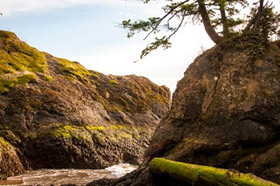
Chinook Cove of the Columbia River
NWNL: How do you think we build a healthy and sustainable relationship between Mother Earth, people, industry and government?
RAY GARDNER: Mother Nature, Mother Earth has a very distinct way of healing herself if we let her. There are solutions. They may be costly to industries, but they will protect the environment.
Change will never happen because people sit back and say nothing. People have to be willing to stand up and say this isn’t right; this is why it’s not right; and you need to change it. Now, they can do that at a city level and they can do that at a county, state or federal level. In a democracy, if enough of the people want something done, it’s the government’s job to make that change. But government will not make a change unless people tell them it needs to be made.
| 






